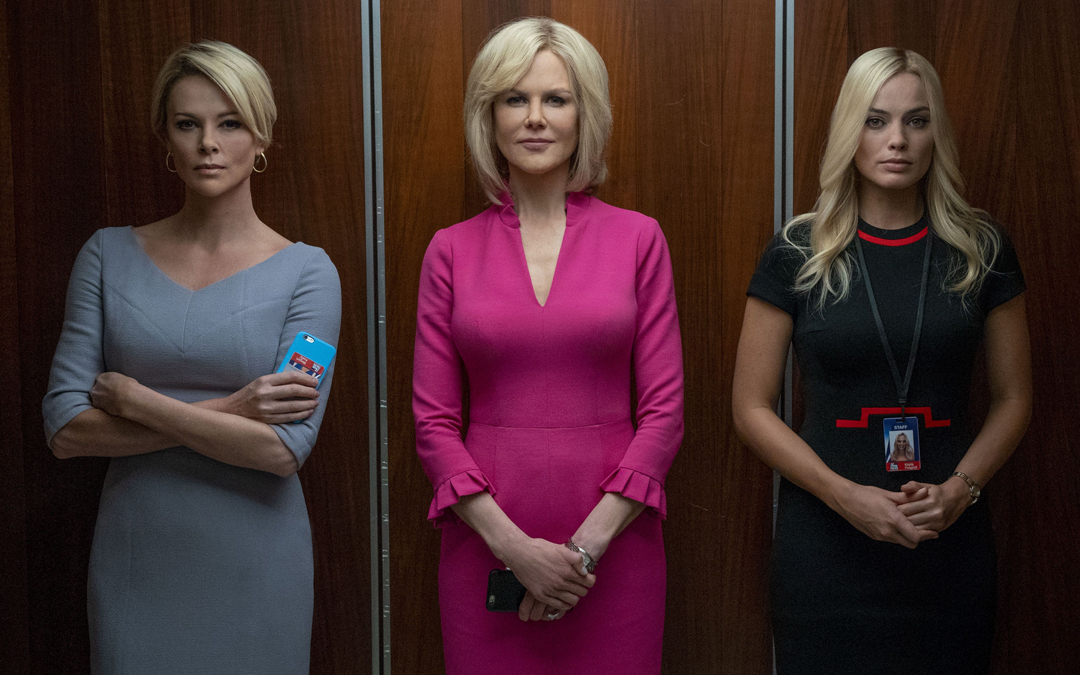All The Write Moves: The Loudest Voice
August 26, 2019
Creating mainstream entertainment centered around controversial political figures is a fraught process, not least because the choice of subject matter has the potential to alienate audiences. In the case of The Loudest Voice, Showtime’s recent miniseries about longtime Fox News executive Roger Ailes, the subject matter is especially toxic. For decades, Ailes played an important behind-the-scenes role in shaping conservative opinion, but in the years immediately preceding his 2017 death, he was toppled by credible accusations of sexual harassment.
Those sympathetic to Ailes’ politics are likely to view The Loudest Voice as a liberal hatchet job, and those opposed to Ailes’ politics are likely to have preexisting opinions affirmed. That’s why The Loudest Voice risks falling into a trap that ensnares many political stories produced in Hollywood—deepening social divisions instead of providing real illumination.
Watching The Loudest Voice, one gets the sense that the show’s creators not only accepted these problematic circumstances but embraced the circumstances. The show is an exercise in impassioned advocacy, endeavoring to explain how right-wing media evolved from noise on the fringes of the political landscape to a powerful machine that helped elect the current president. To say that the creators of The Loudest Voice take a negative view of Ailes’ career and legacy is to grossly understate matters.
That being the case, what can writers learn by studying The Loudest Voice? For one thing, the show demonstrates how popular entertainment can be used to advance a specific political agenda. Plainly, the series wants viewers to become enraged at the way Ailes manipulated public opinion—and to become aware of how insidious methods that Ailes perfected remain in use two years after his passing.
Unfair and Unbalanced
Russell Crowe, making a rare dive into television, plays Ailes from behind bulky clothing and facial prosthetics that simulate Ailes’ overweight build. Employing his signature intensity, Crowe plays Ailes as a sort of charming monster who can talk allies into acting against their own interests but also violently berates subordinates. Furthermore, Ailes is portrayed as a sexual predator. Yet perhaps the most disturbing aspect of the portrayal is the unapologetic way that Ailes blurs lines between journalism and politics.
During a stretch of the series that dramatizes the buildup to the 2003 invasion of Iraq, Ailes makes a startling announcement to his team: “We need to drive the news, not just cover it.” This brazen language is a throwback to the so-called “yellow journalism” of the early 20th century, in which newspaper publishers helped beat the drums of war, sometimes exaggerating or wholly fabricating provocative incidents that triggered military action. Ailes is depicted as being shameless in the pursuit of his goal, which is acquiring and maintaining power for the Republican Party.
This misuse of “news” programming for political purposes reaches an absurd extreme when Ailes, in defiance of direct orders from Fox’s corporate overlords, skews coverage during the 2015-2016 presidential campaign in order to favor Donald Trump.
Skeptics of the Gabriel Sherman book upon which The Loudest Voice is based can reasonably question the assertions the miniseries makes. Nonetheless, there’s a useful lesson here, and it involves clarity and focus. In order to make the desired thematic points about Ailes (and Fox), the creators of the miniseries clearly defined what they perceived as his agenda, then kept the focus on the pursuit of that agenda from episode to episode. As The Loudest Voice progresses, we watch Ailes change from a messenger to a megalomaniac.
Takeaway: One way to depict a character’s relationship with power is to focus on the character’s pursuit of a single agenda over many years.
Give the People What They Want
One of the creepiest tropes in The Loudest Voice involves Ailes repeatedly absolving himself of responsibility for his broadcasting methods by claiming that he’s merely giving the audience what it wants. Sometimes he brushes off criticism by claiming that Fox News is entertainment rather than information. At other times, he dodges questions by claiming that he’s merely feeding the very specific appetites of conservatives. “People don’t want to be informed,” he says. “They want to feel informed.”
This remark leads down a rabbit hole that includes everything from biased coverage to fake news. According to the version of Ailes presented in The Loudest Voice, the responsibility for any social problems associated with Fox News falls not on the people who make Fox News but rather on the people who watch Fox News. In other words, any product is only as good or bad as the people who make it popular. This is of course the worst kind of moral justification, akin to saying that drug addicts, not drug dealers, are responsible for the proliferation of drugs.
And in The Loudest Voice’s telling, Fox News is very much like a drug—a 24/7 infusion of bias confirmation, blending conspiracy theories and scare tactics and outright falsehoods to keep the conservative voting bloc agitated. Yet while this yet again demonstrates how heavy-handed and one-sided The Loudest Voice is, it also raises another consideration that’s helpful for writers. In narratives, villains are only as powerful as their sphere of influence.
Put another way, if The Loudest Voice suggested that Ailes was some sort of guru leading mindless sheep to vote Republican, then the show would deny Fox News viewers agency and respect. Instead, The Loudest Voice suggests Fox News viewers have so much formless angst about the state of the modern world that they are receptive to any ideology that gives form to their angst. After all, believing that Democrats and immigrants are to blame for everything bad in the world suggests easy solutions—defeat Democrats, deport immigrants.
When developing villains for your own stories, take a cue from what the creators of The Loudest Voice did. Instead of merely re-creating Ailes’ actions, they asked why so many people supported his actions. This elevates Ailes from a simple bad guy—an individual with nefarious intent—and repositions him as something much more dangerous, a demagogue who harnesses real public sentiment.
Takeaway: To deepen the portrayal of a villain, ask why people support the villain’s schemes.
The Human Factor
While learning their craft, actors are counseled to avoid judging their characters, thus allowing the actors to portray monstrous individuals as fully dimensional human beings. Generally speaking, it’s wise for writers to follow a similar path, because judging characters—particularly villains—can easily lead to one-dimensional characterizations. In this context, it’s interesting to consider whether the creators of The Loudest Voice sought to humanize Roger Ailes, because a strong argument could be made that they did not.
Although Ailes is shown as having weaknesses, from a fragile ego to a litany of medical problems, he is rarely portrayed as having empathy. Quite to the contrary, he sometimes seems like a sociopath, using and discarding people with little thought to the consequences of his actions. Bosses, coworkers, subjects of news stories, women—they are all commodities that Ailes consumes. Given this seemingly one-dimensional approach to characterization, here’s the obvious question: Why did the smart people behind The Loudest Voice allow the character at the center of their storyline to come across as a pure villain?
One difficult answer might be that Sherman, in researching the book upon which The Loudest Voice is based, found no evidence of empathy in the real Ailes’ behavior. A more convenient answer would be that the creators of the miniseries put their thumbs on the scale, thematically speaking. Frustratingly, however, the truth probably lies somewhere between these extremes.
After all, looking more closely at the portrayal of Ailes reveals a certain degree of humanization, just not the type we’re accustomed to seeing. In its simplest form, humanizing a villain involves giving the villain admirable or likeable qualities. In The Loudest Voice, Ailes is “admirable” in the sense that he’s skilled at achieving his goals, and he’s “likeable” in that he’s good at telling people what they want to hear when the occasion calls for puffery. Coursing beneath these aspects of his characterization is our knowledge that everything Ailes does hurts someone. It is also true that it’s easy to empathize with Ailes once his body starts to fail him, even though his physical decline coincides with scenes of great cruelty.
The point is that some characters exist in a place far beyond conventional moral redemption—the damage they inflict on the world grossly outweighs any small kindnesses they might perform. Accordingly, not every character deserves the same level of humanization, because softening these characters would deny the truth of their villainy. So, when developing villains, remember that you need not invest such characters with warmth—sometimes it’s more honest to simply imbue them with weaknesses as a contrast to the power they exercise in most scenes.
Takeaway: Add depth to powerful characters by illustrating their weaknesses.
Written by: Peter Hanson
Peter Hanson is a Los Angeles-based writer, filmmaker and teacher. He directed the screenwriting documentary Tales from the Script, and he teaches at Pepperdine University and UCLA Extension. He provides script consulting at www.GrandRiverFilms.com.- Topics:
- Discussing TV & Film




